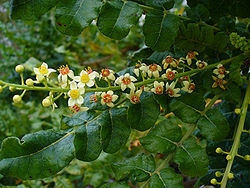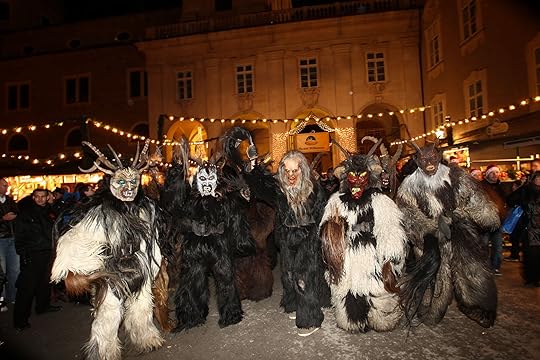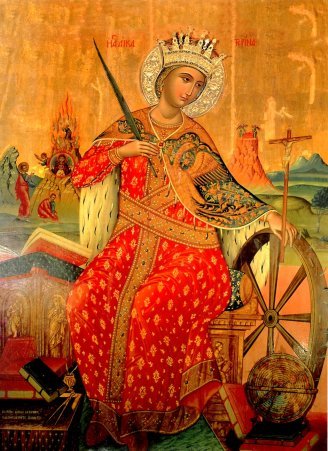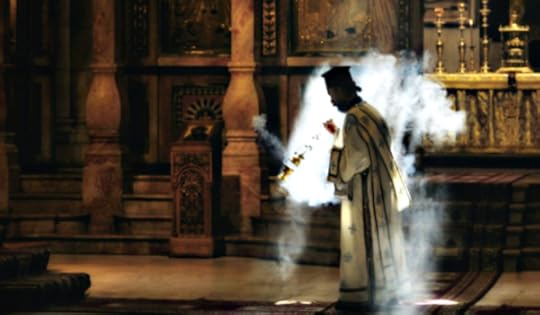Stephen Morris's Blog, page 40
January 4, 2016
Epiphany Cake

One of the kings from the 2015 Epiphany parade in Prague.
Epiphany, traditionally celebrated on January 6, is the celebration (in Western Christianity) of the arrival of the Magi to adore the Christ Child. (Among the Eastern Christians, the Epiphany is the celebration of the Baptism of Christ.) There are many traditional festivities, such as the Three Kings Parades — one of the best is in East Harlem! But the one in Prague (seen above) is pretty splendid as well.
An Epiphany Cake, also called a King Cake, is customarily served at the festive dinner on January 6. Inside the cake are often placed a bean or other trinkets, to indicate good fortune or wealth in the coming year as well as to mark who will be responsible for baking the cake at the next Epiphany celebration.
Here is my favorite Epiphany Cake recipe:
Ingredients:
2 1/4 cups flour
1 1/2 cups sugar
3 tsps. baking powder
1 tsp salt
1/2 cup butter
1 cup milk
1 1/2 tsps. vanilla
2 eggs
Directions:
Preheat oven to 350 degrees. Lightly grease and flour cake pan.
Melt the butter in a small pan on the stove.
Mix together all the dry ingredients.
Add the eggs, vanilla, and milk. Mix well.
Add the melted butter. Mix well again.
Pour batter into cake pan.
Bake approx. 45-60 minutes.
Most important: Don’t forget to lick the bowl and spoon!
Icing (if desired):
1/4 cup butter, melted and cooled
1/4 cup cream
2 tsps. vanilla
3 cups sugar
Combine the butter, cream, and vanilla.
Slowly add the sugar.
Add more sugar or a few more drops of cream to reach the proper consistency.
Spread on cool cake.
Again — don’t forget to lick the bowl and spoon!
The post Epiphany Cake appeared first on Stephen Morris, author.
January 2, 2016
Blog Stats 2015
This just in! We got the stats on the performance of the StephenMorrisAuthor.com blog during the year that we just rang out! During 2015, it seems that:
The concert hall at the Sydney Opera House holds 2,700 people. This blog was viewed about 14,000 times in 2015. If it were a concert at Sydney Opera House, it would take about 5 sold-out performances for that many people to see it.
The busiest day of the year was December 7th with 162 views. The most popular post that day was Frankincense.
The other most posts that were viewed the most times over the course of the year were
1. Lily of the Valley (originally posted May 2013)
2. Emerald (originally posted May 2013)
3. Marigold, the “birth flower” of October (originally posted October 2013)
4. Pope Innocent VIII and the witches (originally posted July 2013)
5. Daffodil, the flower of March (originally posted March 2013)
To compare with the blog performance in past years, click here and here.
What was YOUR favorite post??
The post Blog Stats 2015 appeared first on Stephen Morris, author.
December 28, 2015
Holy Innocents’ Day

The Massacre of the Innocents (detail) by Lucas Cranach the Elder (c. 1515), National Museum in Warsaw.
Also known as Innocents’ Day or Childermas, this day commemorates the massacre of all the male children two years and under in Bethlehem as ordered by King Herod, who hoped that the infant Jesus would be among them. Not surprisingly, this day has long been regarded as unlucky—particularly for getting married or undertaking any important task. Edward IV of England went so far as to change the day of his coronation when he realized it would fall on December 28. Most modern folk recognize the account of the slaying of the children from the popular Coventry Carol.
In ancient times, the “Massacre of the Innocents” was reenacted by whipping the younger members of a family. But over the years the tables turned, and in some countries it has become a day when children play pranks on their elders. In Mexico, Childermas is the equivalent of April Fool’s Day. In some areas of western Europe, the day of the week on which Holy Innocents’ fell was considered a holiday in each following week of the year until the next celebration of the feast. Or, in some places, that weekday was considered unlucky and ill-omened in each week until the next Holy Innocents’ Day.
The Greek liturgy asserts that Herod killed 14,000 boys, the Syrians speak of 64,000, many medieval authors of 144,000 (the number of the young men in white described in Revelation 14:3). Modern writers reduce the number considerably, since Bethlehem was a rather small town. Modern scholars now consider the number of children killed to have been more likely fifteen or twenty. This cruel deed of Herod is not mentioned by the Jewish historian Flavius Josephus, although he relates quite a number of atrocities committed by the king during the last years of his reign. The number of these children was so small that this crime appeared insignificant amongst the other misdeeds of Herod. One ancient historian relates that when Augustus heard that amongst the boys of two years and under Herod’s own son also had been massacred, he said: “It is better to be Herod’s hog [ous], than his son [houios],” alluding to the Jewish law of not eating, and consequently not killing, swine.
The post Holy Innocents’ Day appeared first on Stephen Morris, author.
December 21, 2015
The Star of Bethlehem

Eastern Orthodox icon of the birth of Christ by St. Andrei Rublev, 15th century. Note that the shepherd speaking with St. Joseph in the lower left is shown in profile, a pose reserved only for this shepherd, the Devil, and for Judas Iscariot and which indicates their interior wickedness and efforts to hide themselves from God. Also, the cave in which Christ is born is painted with the same absolute black pigment — unmixed with any other dark colors, which is more usual — as is the tomb of Christ or the abyss of Hell, into which the Divine Presence has entered.
“We have seen his star in the East,” the magi told King Herod. “We have come to worship him.”
This news was a surprise to King Herod. He had no idea that a new King of the Jews had been born and had clearly NOT seen the star the magi had. What was the “star” which the magi claimed they had seen and which had told them to come find the newborn King in Judea? Since no one in Jerusalem seems to have seen it, the star could not have been a bright light in the sky or they would have noticed it. Since the Gospel text says that Herod later had all the boys aged two years or younger killed in his attempt to kill the Christ Child, the “star” must have been an astronomical event of some sort rather than a bright light or all the other parents whose children were butchered by Herod’s soldiers would have pointed out the house and said, “No! Not our children — the boy you want is in that house! There!” Also, the magi evidently had seen the star at least 2 years before and it had taken them that long to travel to Jerusalem.
I remember reading reports in December 1975 (my senior year of high school!) that the “star” was in fact a conjunction of Saturn and Jupiter in the constellation Pisces — and that this conjunction occurs once every 800 years! The magi, being astrologers, would have understood this to mean that a great king (Jupiter) who would usher in the End of Days (Saturn) was being born in Judea (Pisces). This conjunction occurred in December 1975, according to these reports, but I was unable to see it as I was not sure exactly where to look in the sky or on which date(s) to look.
In Orthodox icons (such as the one above), the Star of Bethlehem is often depicted not as a bright light but as a dark aureola, a semicircle at the top of the icon, indicating the “divine darkness” or Uncreated Light of Divine grace, with a ray pointing to “the place where the young child lay” (Matt 2:9). Sometimes the faint image of an angel is drawn inside the dark semi-circle, pointing the way for the Magi.
The post The Star of Bethlehem appeared first on Stephen Morris, author.
December 14, 2015
All I Want for Christmas is… a Goldfinch?!

Madonna and Child, by Carlo Crivelli (1480); note the goldfinch in the Christ Child’s grasp
Very often in traditional depictions of the Virgin and Christ Child, there is a goldfinch in the baby’s grasp. Why?
The most simple reason might be that in the 14th century it was common for young children to keep tame birds as pets. Christ’s holding a bird allows a parent or a child to recognize his human nature, to identify with him. Despite the angels and the celestial gold background, the viewer is reminded that God lived and died as a man upon the earth.
But when is traditional Christian art ever simple? Or easy?
The goldfinch appears in depictions of Christ’s birth or during his childhood because it was said that when Christ was carrying the cross to Calvary a small bird – sometimes a goldfinch, sometimes a robin – flew down and plucked one of the thorns from the crown around his head. Some of Christ’s blood splashed onto the bird as it drew the thorn out, and to this day goldfinches and robins have spots of red on their plumage. Since goldfinches are also known to eat and nest among thorns, the goldfinch is often read as a prefiguration of Christ’s Passion.
The bird could also be seen as a symbol of the Resurrection of Christ. A non-Biblical legend popular in the Middle Ages related how the child Jesus, when playing with some clay birds that his friends had given to him, bought them to life. Medieval theologians saw this as an allegory of his own coming back from the dead.
Medieval Europeans also saw the goldfinch as a protector against the plague. Since classical times superstition had credited a mythical bird – the charadrius – with the ability to take on the disease of any man who looked it in the eye. The charadrius was sometimes represented as a goldfinch. Perhaps Christ’s finch offers the worshiper protection against the seemingly unstoppable contagion.
Also, since Ancient Egypt, the human soul had been represented in religious art by a small bird. We see the “Ba” (the soul-bird) on a detail of an Egyptian coffins. A very general reading of the goldfinch might, therefore, remind the viewer that his soul is ‘in the hands’ of God.
Curious about that big cucumber hanging from the apple tree? Hmmm… Read an interesting interpretation of it here.
The post All I Want for Christmas is… a Goldfinch?! appeared first on Stephen Morris, author.
December 7, 2015
Frankincense

“Olibanum resin” by Peter Presslein – photo taken by Peter Presslein. Licensed under CC BY-SA 3.0 via Commons – https://commons.wikimedia.org/wiki/Fi...
Frankincense, recognized as one of the gifts — together with gold and myrrh — that the Magi brought to the Christ Child, is derived from the resin of certain kinds of trees that grow in the Middle East and Africa. Called “frankincense” because the Franks had a near-monopoly on importing it into Western Europe during the Middle Ages, it has always been the one of the most precious (i.e. expensive!) kinds of incense available; hence, its association with gold as an appropriate gift for the Christ Child. (Nowadays, frankincense is still very expensive in most cases but can sometimes be purchased for more reasonable prices here.) Used in the Temple in Jerusalem before the Romans destroyed it in 70 A.D., frankincense is still burned year-round as incense in many Christian churches although some only use it at Christmas-time.
In many medieval sermons, frankincense was associated with death and resurrection because the phoenix was said to return to Egypt to set itself aflame in a frankincense tree. Burnt to ash in a fragrant cloud of incense, the famous nearly immortal bird was reborn as a small worm crawling from the ashes. This worm grew into a new phoenix. The air in the Garden of Eden was said to have smelled like frankincense, which is why devils and demons were said to still flee from burning frankincense since it reminds them of the Paradise they were driven from and are still denied.

Flowers and branches of the Boswellia sacra tree, the species from which most frankincense is derived
The “pearls” or “tears” of frankincense resin melt when they are placed atop burning coals; the fragrant smoke is released as the resin melts. The fragrant smoke rising from the charcoal is often used as an image of prayer. Recipes for other scents or fragrances of incense are often perfumes added to frankincense, which remains the basis for much incense still used in the modern world.
The post Frankincense appeared first on Stephen Morris, author.
November 30, 2015
Krampus… friend of St. Nicholas?!

St. Nicholas and the Krampus procession in Salzburg (2010); photo by Charlotte Anne Brady.

Krampus revels at the Salzburg Christmas Market, 2011; photo by Neumayr/MMV 05.12.2011
Traditionally on December 5th and 6th, St. Nicholas walks from house to house in the cities and villages of the Alps to admonish and laud young and old. He is mostly accompanied by a Krampus (an evil creature, a devil of sorts), who is going to punish the bad children and adults on St. Nicholas′ command. For the honest children he normally has little presents.
St. Nicholas himself is a Christian figure, more precisely the former bishop of Myra. As son of a well situated family he started to help poor people who lived in deep poverty. He was supposed to have miraculous vigor and so he became patron of the seamen, children and poor people. (See a previous post about St. Nicholas and his care for the poor here.) In most modern versions of the St. Nicholas story, he is accompanied by a monster or servant (the Dutch describe his assistant as Black Peter) who punishes the bad children while Nicholas himself rewards the well-behaved children.
The figure of the Krampus is based on pre-Christian custom. The Krampusse not only punish the bad children but had the function at one time of driving out the winter devils and blizzard sprites. Originally the custom of the Krampus was spread over all of Austria but was forbidden by the Catholic Church during the Inquisition. It was prohibited by death to masquerade as a devil or an evil creature and so this custom only survived in some remote, inaccessible, regions of the Alps from where it slowly spread back across the western parts of Austria again. Today the Krampusse revels are especially popular in Salzburg.
The post Krampus… friend of St. Nicholas?! appeared first on Stephen Morris, author.
November 23, 2015
St. Catherine and her Wheel

A woodprint depicting the execution of Peter Stumpp, a famous convicted werewolf, on the wheel in Cologne.

A woodcut depicting how the limbs of a victim would be laced through the spokes of the wheel.

An icon of St. Catherine, with her wheel. Note the 2 images of Mt. Sinai in the background: Moses at the burning bush on the left and the later fortress-monastery on the right.
One of the most popular women of the Middle Ages, St. Catherine was thought to have been a 4th century philosopher in Alexandria who was martyred in the Great Persecution of Diocletion. Her biography indicates she was tortured on the wheel and finally beheaded; her relics were taken by “angels” (a euphemism commonly used to mean monks) to the monastic settlement on Mount Sinai. A monastery-fortress was built there by the Byzantine emperor Justinian in the 6th century; extremely rare and priceless icons and manuscripts have survived there because it was so remote. Her feast day, on November 24 or 25 (in various places), was one of the most popular holidays of the year. It was said that if there was snow on St. Catherine’s day, it would be a hard winter. If an unmarried girl wanted a husband or a married woman wanted to be rid of a bad husband, she should fast on St. Catherine’s day and the saint would either produce a husband or reform/dispatch him as required.
Because of St. Catherine’s association with the wheel, the “St. Catherine’s wheel” firework is probably the first association modern people think of. But in the Middle Ages the use of the wheel as an instrument of torture was a frequent sight in town squares across Europe. People would be tortured on the wheel in several ways but the worst — though least known today — was lacing the broken limbs of a victim through the spokes of the wheel and then spinning the victim to induce nausea as well as pain.
Because crucifixion was no longer practiced in Europe, artists had no models to paint from when depicting the crucifixion of Christ. It was the victims of the wheel that were most often used as models for depicting crucifixions, especially the two thieves on either side of Christ: the contortions of the crucified thieves display the positions commonly seen in victims of the wheel rather than what we now know to be the positions of victims of crucifixion. So, in fact, when we see medieval or Renaissance paintings of the crucifixion scene, we are often actually seeing depictions of contemporary victims of the wheel used as models by the artists.
There is no shortage of books about medieval torture, describing the wheel as well as other instruments used to provoke confessions of guilt from the accused. Although we, as modern people, are not surprised that people accused of outlandish crimes in the Middle Ages — such as being a werewolf or a witch — would confess simply to stop the torture it was the presumption of Classical Roman and medieval people that people subjected to torture would never lie; this must still be the presumption behind the use of “enhanced interrogation,” I think.
The post St. Catherine and her Wheel appeared first on Stephen Morris, author.
November 16, 2015
Our Lady of Deliverance

The altarpiece in Our Lady of Deliverance in Venice; note the angel on the right driving away Lady Plague with a torch.

The bridge in 2011 to allow the procession to Our Lady of Deliverance in Venice.
Each year on November 21, the feast of the Entrance of the Mother of God into the Temple, a bridge is built across the water in Venice to allow a procession of the city council and the citizens of the city to Our Lady of Deliverance in thanksgiving for the end of the plague.
Beginning in the summer of 1630, a wave of the plague assaulted Venice, killing nearly a third of the population by 1631. In the city, 46,000 people died whilst in the lagoons the number was far higher, some 94,000. As a votive offering for the city’s deliverance from the pestilence, the Republic of Venice vowed to build and dedicate a church to Our Lady of Health (or of Deliverance, Italian: Salute). It was also decided that the Senate would visit the church each year on November 21 the Feast of the Presentation of the Virgin, also known as the Festa della Madonna della Salut. The city’s officials still parade from San Marco to the Salute for a service in gratitude for deliverance from the plague. This involves crossing the Grand Canal on a specially constructed pontoon bridge and is still a major event in Venice.
There are several such “plague churches” in Venice, each built to celebrate the end of one outbreak of plague or another. The plague was one of the most fearsome diseases anyone could face (until the development of modern antibiotics); an outbreak of the plague in a town was probably the most terrible thing the inhabitants could face, except war. Plague was fought with prayer and fasting, fire (burning the houses and corpses of the sick), and efforts to avoid the poisonous fumes or “miasmas” that were thought to spread the disease. (Sometimes poisoned water was thought to spread the disease as well.)
Plague, as all illnesses, was seen as a disruption of the balance of the four humors of the human body. Doctors sought to heal a patient by restoring the balance of the humors, often by “bleeding” a patient to remove the excessive humors; folk healers used herbs and plants to heal patients and the modern heirs of these folk healers are the pharmacists who provide medicine at a local pharmacy. “Pharmacology” was the Greek word for witchcraft because if a person knew how to use herbs and plants to heal, the person was assumed to know how to use these same herbs and plants to kill. Many people accused of witchcraft might still be put on trial today — but as poisoners, not witches.
The post Our Lady of Deliverance appeared first on Stephen Morris, author.
November 9, 2015
Crowhaven Farm

The witches of Crowhaven Farm gather to confront Hope Lange, a modern woman who still owes them for a favor they performed for her in a previous life.

This screen shot opened the MOVIE OF THE WEEK episode every Tuesday and Wednesday evenings on ABC — back in the days when there were only 3 networks, plus PBS!
When I was in middle school, one of the scariest movies I have ever seen was broadcast as an ABC Tuesday night made-for-tv Movie of the Week. (Looking over the list of films shown during the run of the series, I still recognize many of them!) But the most riveting was Crowhaven Farm.
First broadcast in the autumn of 1970, Crowhaven Farm starred Hope Lange (known for the series The Ghost and Mrs. Muir) and Paul Burke (known for the television series Twelve O’clock High). As one horror review blog puts it:
“The writers of this show clearly understood horror, they understood that fear is in the mind and that nothing terrifies people more than their own imaginations. Contemporary television shows too much, it tells too much. Crowhaven Farm is spooky, scary, downright terrifying, simply because it makes you think.”
The movie tells the story of a modern woman, played by Hope Lange, who still owes the local witches for a favor they did her during a previous life during the 1600s. Too cowardly to give the witches what they asked for, in both her previous and current lives, she forces them to resort to other methods to be rewarded for the favors they did for her as well as exact revenge for how she cheated them in the 1600s. It is a remarkably subtle movie, with nuances and foreshadowings. It does not rely on slashing-and-gashing to frighten the viewer and many of its most frightening images, which appear here for the first time, later became clichés of the genre.
I heartily recommend that you spend an hour-and-fifteen-minutes to watch this classic movie, which is available here on YouTube. Send me your comments about it, especially if you have never seen it before or have not seen it since you were in high school yourself — I still get chills, just thinking about it!
The post Crowhaven Farm appeared first on Stephen Morris, author.





